Childcare Environment Assessment 3: Strategies and Analysis
VerifiedAdded on 2020/03/01
|55
|4773
|16
Homework Assignment
AI Summary
This assignment is a detailed analysis of a childcare environment catering to toddlers from diverse backgrounds in Australia. It explores the core principles of child development, emphasizing physical, mental, and cognitive skills through a play-based curriculum. The assignment highlights the importance of observation, documentation, reflection, and implementation in developing effective care plans. It focuses on five key skills: communication, cognition, motor development, social skills, and emotional development, integrating various indoor and outdoor activities. The learning environment promotes cultural competence and collaboration, preventing biases and prejudices. The analysis includes individual child assessments, outlining specific needs and implications for planning for children named Taya, Khade and Andrew, addressing their preferences, behaviors, and family dynamics to tailor interventions that enhance their overall development. The assignment emphasizes the importance of family involvement and a multicultural environment to foster well-rounded individuals.
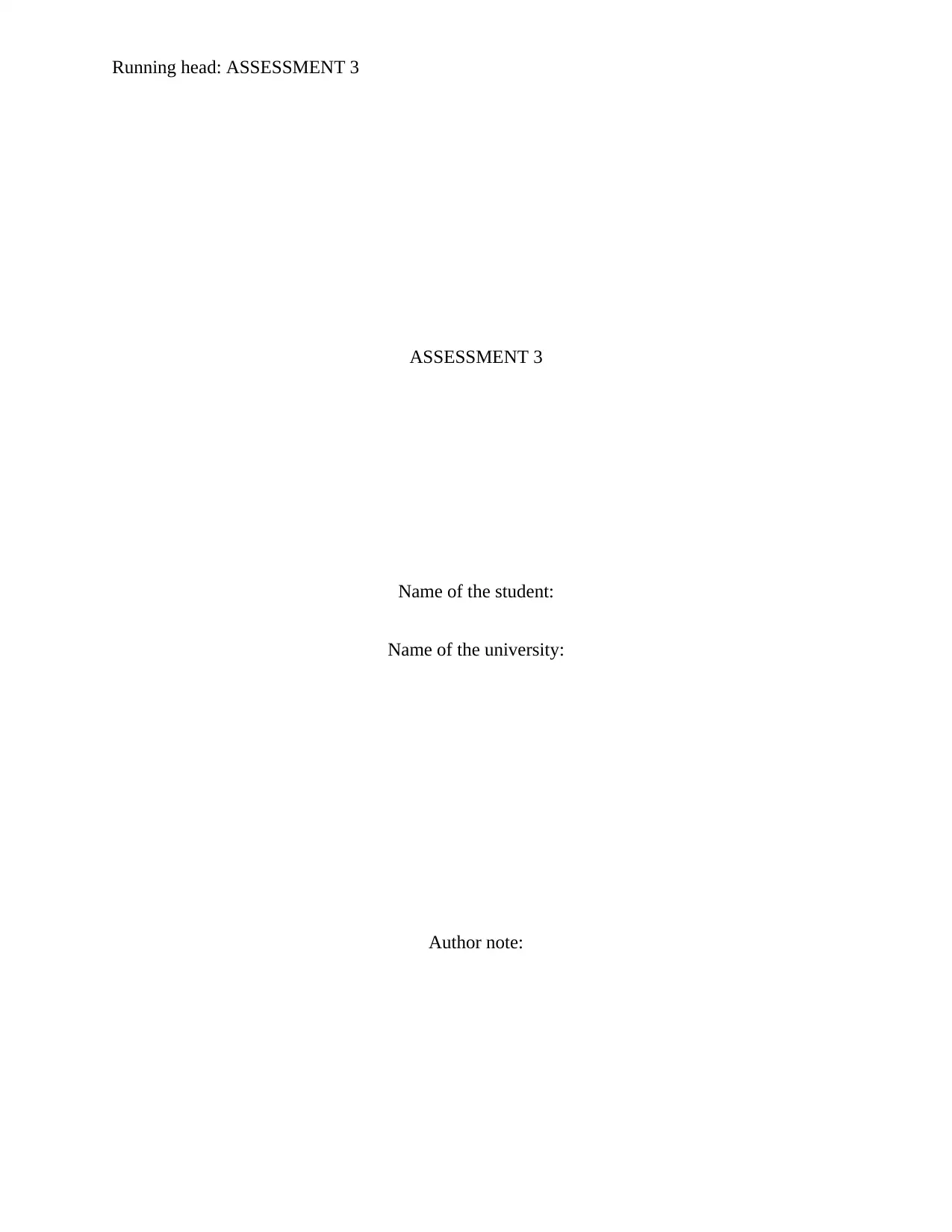
Running head: ASSESSMENT 3
ASSESSMENT 3
Name of the student:
Name of the university:
Author note:
ASSESSMENT 3
Name of the student:
Name of the university:
Author note:
Paraphrase This Document
Need a fresh take? Get an instant paraphrase of this document with our AI Paraphraser
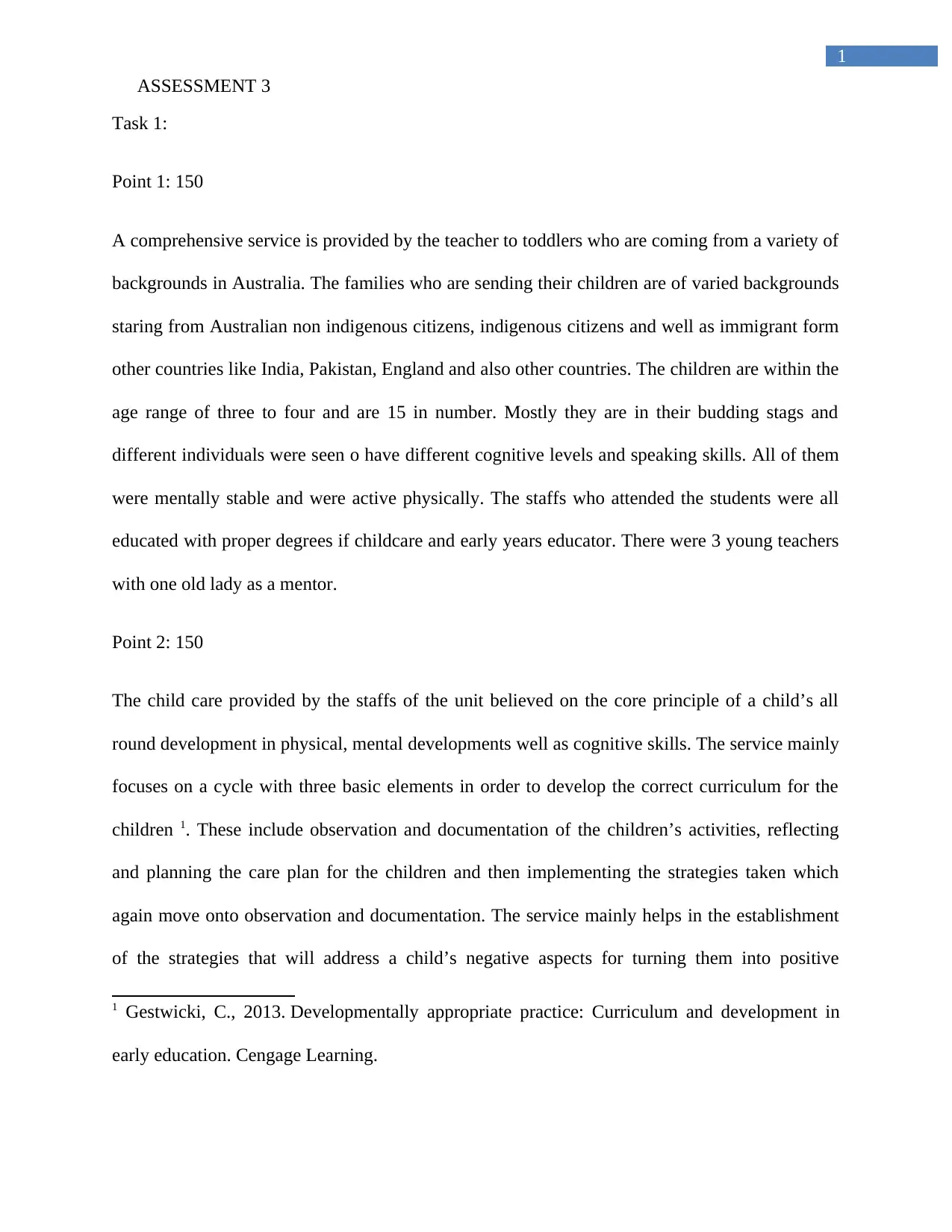
1
ASSESSMENT 3
Task 1:
Point 1: 150
A comprehensive service is provided by the teacher to toddlers who are coming from a variety of
backgrounds in Australia. The families who are sending their children are of varied backgrounds
staring from Australian non indigenous citizens, indigenous citizens and well as immigrant form
other countries like India, Pakistan, England and also other countries. The children are within the
age range of three to four and are 15 in number. Mostly they are in their budding stags and
different individuals were seen o have different cognitive levels and speaking skills. All of them
were mentally stable and were active physically. The staffs who attended the students were all
educated with proper degrees if childcare and early years educator. There were 3 young teachers
with one old lady as a mentor.
Point 2: 150
The child care provided by the staffs of the unit believed on the core principle of a child’s all
round development in physical, mental developments well as cognitive skills. The service mainly
focuses on a cycle with three basic elements in order to develop the correct curriculum for the
children 1. These include observation and documentation of the children’s activities, reflecting
and planning the care plan for the children and then implementing the strategies taken which
again move onto observation and documentation. The service mainly helps in the establishment
of the strategies that will address a child’s negative aspects for turning them into positive
1 Gestwicki, C., 2013. Developmentally appropriate practice: Curriculum and development in
early education. Cengage Learning.
ASSESSMENT 3
Task 1:
Point 1: 150
A comprehensive service is provided by the teacher to toddlers who are coming from a variety of
backgrounds in Australia. The families who are sending their children are of varied backgrounds
staring from Australian non indigenous citizens, indigenous citizens and well as immigrant form
other countries like India, Pakistan, England and also other countries. The children are within the
age range of three to four and are 15 in number. Mostly they are in their budding stags and
different individuals were seen o have different cognitive levels and speaking skills. All of them
were mentally stable and were active physically. The staffs who attended the students were all
educated with proper degrees if childcare and early years educator. There were 3 young teachers
with one old lady as a mentor.
Point 2: 150
The child care provided by the staffs of the unit believed on the core principle of a child’s all
round development in physical, mental developments well as cognitive skills. The service mainly
focuses on a cycle with three basic elements in order to develop the correct curriculum for the
children 1. These include observation and documentation of the children’s activities, reflecting
and planning the care plan for the children and then implementing the strategies taken which
again move onto observation and documentation. The service mainly helps in the establishment
of the strategies that will address a child’s negative aspects for turning them into positive
1 Gestwicki, C., 2013. Developmentally appropriate practice: Curriculum and development in
early education. Cengage Learning.
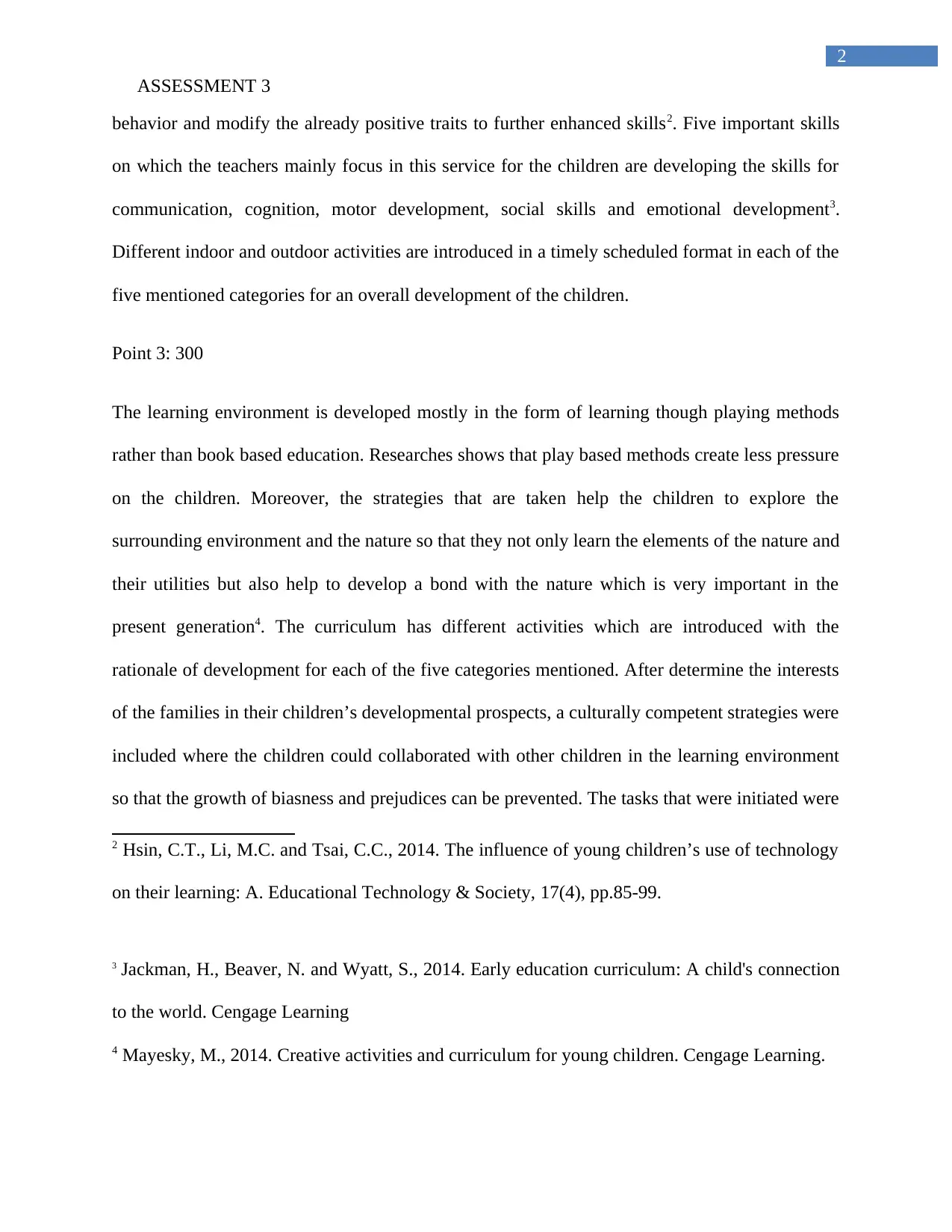
2
ASSESSMENT 3
behavior and modify the already positive traits to further enhanced skills2. Five important skills
on which the teachers mainly focus in this service for the children are developing the skills for
communication, cognition, motor development, social skills and emotional development3.
Different indoor and outdoor activities are introduced in a timely scheduled format in each of the
five mentioned categories for an overall development of the children.
Point 3: 300
The learning environment is developed mostly in the form of learning though playing methods
rather than book based education. Researches shows that play based methods create less pressure
on the children. Moreover, the strategies that are taken help the children to explore the
surrounding environment and the nature so that they not only learn the elements of the nature and
their utilities but also help to develop a bond with the nature which is very important in the
present generation4. The curriculum has different activities which are introduced with the
rationale of development for each of the five categories mentioned. After determine the interests
of the families in their children’s developmental prospects, a culturally competent strategies were
included where the children could collaborated with other children in the learning environment
so that the growth of biasness and prejudices can be prevented. The tasks that were initiated were
2 Hsin, C.T., Li, M.C. and Tsai, C.C., 2014. The influence of young children’s use of technology
on their learning: A. Educational Technology & Society, 17(4), pp.85-99.
3 Jackman, H., Beaver, N. and Wyatt, S., 2014. Early education curriculum: A child's connection
to the world. Cengage Learning
4 Mayesky, M., 2014. Creative activities and curriculum for young children. Cengage Learning.
ASSESSMENT 3
behavior and modify the already positive traits to further enhanced skills2. Five important skills
on which the teachers mainly focus in this service for the children are developing the skills for
communication, cognition, motor development, social skills and emotional development3.
Different indoor and outdoor activities are introduced in a timely scheduled format in each of the
five mentioned categories for an overall development of the children.
Point 3: 300
The learning environment is developed mostly in the form of learning though playing methods
rather than book based education. Researches shows that play based methods create less pressure
on the children. Moreover, the strategies that are taken help the children to explore the
surrounding environment and the nature so that they not only learn the elements of the nature and
their utilities but also help to develop a bond with the nature which is very important in the
present generation4. The curriculum has different activities which are introduced with the
rationale of development for each of the five categories mentioned. After determine the interests
of the families in their children’s developmental prospects, a culturally competent strategies were
included where the children could collaborated with other children in the learning environment
so that the growth of biasness and prejudices can be prevented. The tasks that were initiated were
2 Hsin, C.T., Li, M.C. and Tsai, C.C., 2014. The influence of young children’s use of technology
on their learning: A. Educational Technology & Society, 17(4), pp.85-99.
3 Jackman, H., Beaver, N. and Wyatt, S., 2014. Early education curriculum: A child's connection
to the world. Cengage Learning
4 Mayesky, M., 2014. Creative activities and curriculum for young children. Cengage Learning.
⊘ This is a preview!⊘
Do you want full access?
Subscribe today to unlock all pages.

Trusted by 1+ million students worldwide
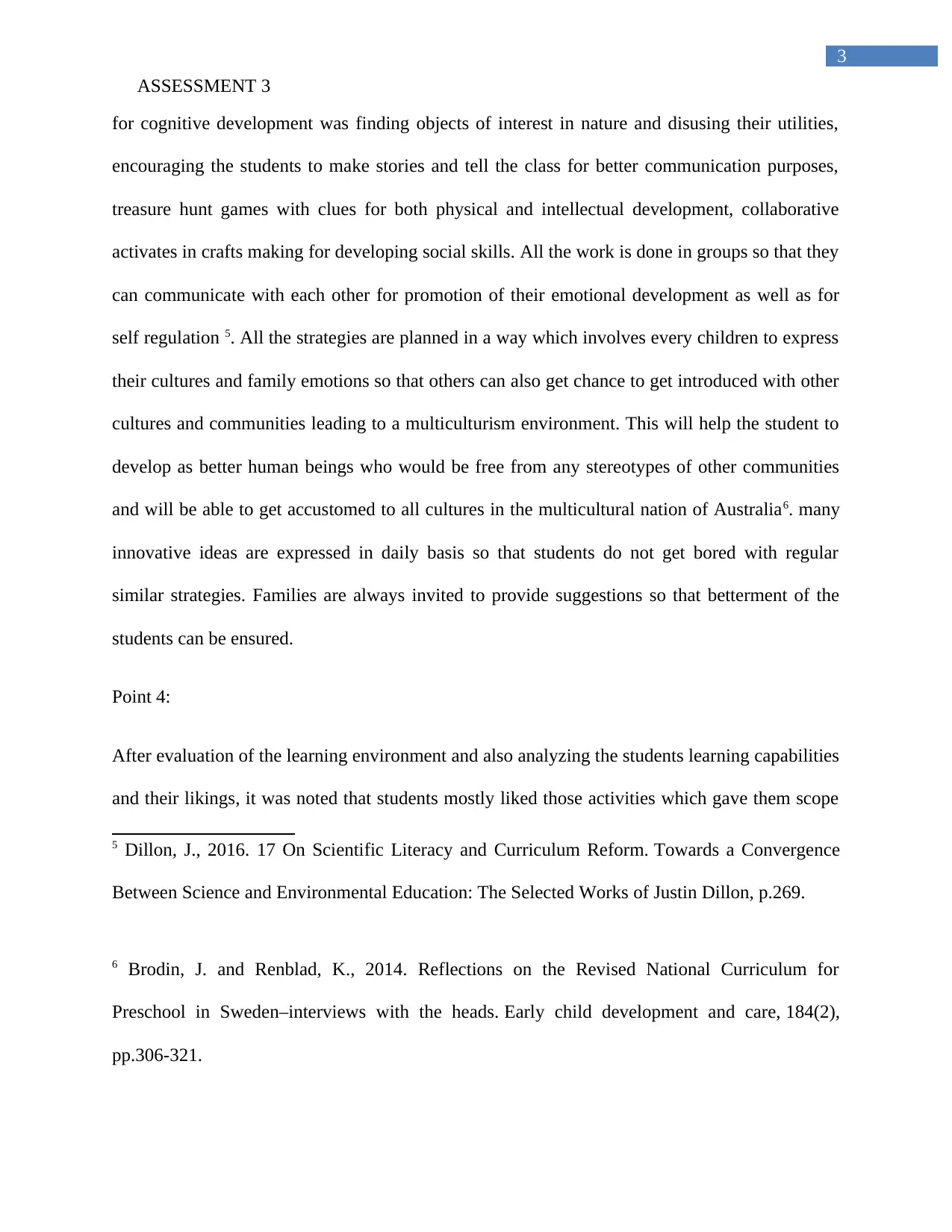
3
ASSESSMENT 3
for cognitive development was finding objects of interest in nature and disusing their utilities,
encouraging the students to make stories and tell the class for better communication purposes,
treasure hunt games with clues for both physical and intellectual development, collaborative
activates in crafts making for developing social skills. All the work is done in groups so that they
can communicate with each other for promotion of their emotional development as well as for
self regulation 5. All the strategies are planned in a way which involves every children to express
their cultures and family emotions so that others can also get chance to get introduced with other
cultures and communities leading to a multiculturism environment. This will help the student to
develop as better human beings who would be free from any stereotypes of other communities
and will be able to get accustomed to all cultures in the multicultural nation of Australia6. many
innovative ideas are expressed in daily basis so that students do not get bored with regular
similar strategies. Families are always invited to provide suggestions so that betterment of the
students can be ensured.
Point 4:
After evaluation of the learning environment and also analyzing the students learning capabilities
and their likings, it was noted that students mostly liked those activities which gave them scope
5 Dillon, J., 2016. 17 On Scientific Literacy and Curriculum Reform. Towards a Convergence
Between Science and Environmental Education: The Selected Works of Justin Dillon, p.269.
6 Brodin, J. and Renblad, K., 2014. Reflections on the Revised National Curriculum for
Preschool in Sweden–interviews with the heads. Early child development and care, 184(2),
pp.306-321.
ASSESSMENT 3
for cognitive development was finding objects of interest in nature and disusing their utilities,
encouraging the students to make stories and tell the class for better communication purposes,
treasure hunt games with clues for both physical and intellectual development, collaborative
activates in crafts making for developing social skills. All the work is done in groups so that they
can communicate with each other for promotion of their emotional development as well as for
self regulation 5. All the strategies are planned in a way which involves every children to express
their cultures and family emotions so that others can also get chance to get introduced with other
cultures and communities leading to a multiculturism environment. This will help the student to
develop as better human beings who would be free from any stereotypes of other communities
and will be able to get accustomed to all cultures in the multicultural nation of Australia6. many
innovative ideas are expressed in daily basis so that students do not get bored with regular
similar strategies. Families are always invited to provide suggestions so that betterment of the
students can be ensured.
Point 4:
After evaluation of the learning environment and also analyzing the students learning capabilities
and their likings, it was noted that students mostly liked those activities which gave them scope
5 Dillon, J., 2016. 17 On Scientific Literacy and Curriculum Reform. Towards a Convergence
Between Science and Environmental Education: The Selected Works of Justin Dillon, p.269.
6 Brodin, J. and Renblad, K., 2014. Reflections on the Revised National Curriculum for
Preschool in Sweden–interviews with the heads. Early child development and care, 184(2),
pp.306-321.
Paraphrase This Document
Need a fresh take? Get an instant paraphrase of this document with our AI Paraphraser
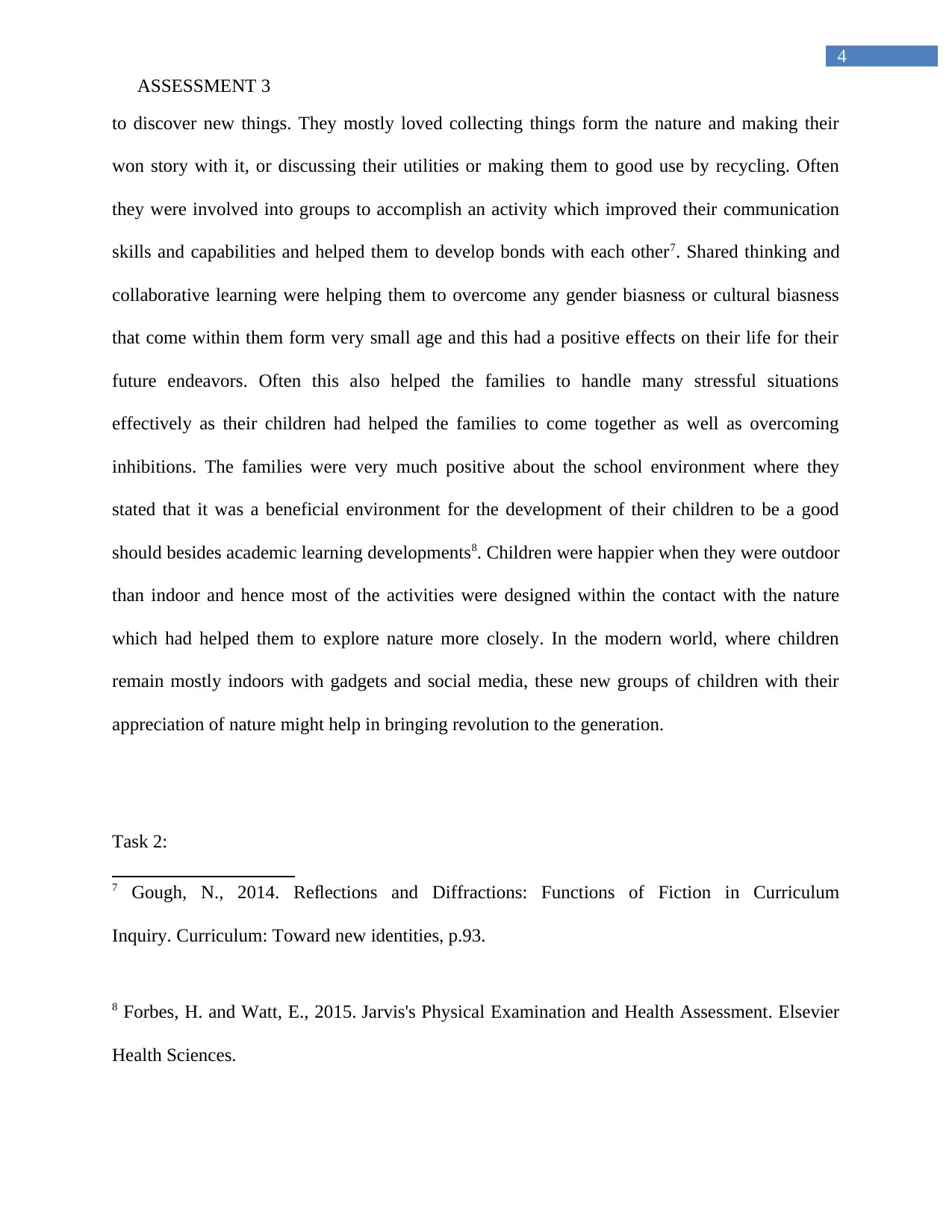
4
ASSESSMENT 3
to discover new things. They mostly loved collecting things form the nature and making their
won story with it, or discussing their utilities or making them to good use by recycling. Often
they were involved into groups to accomplish an activity which improved their communication
skills and capabilities and helped them to develop bonds with each other7. Shared thinking and
collaborative learning were helping them to overcome any gender biasness or cultural biasness
that come within them form very small age and this had a positive effects on their life for their
future endeavors. Often this also helped the families to handle many stressful situations
effectively as their children had helped the families to come together as well as overcoming
inhibitions. The families were very much positive about the school environment where they
stated that it was a beneficial environment for the development of their children to be a good
should besides academic learning developments8. Children were happier when they were outdoor
than indoor and hence most of the activities were designed within the contact with the nature
which had helped them to explore nature more closely. In the modern world, where children
remain mostly indoors with gadgets and social media, these new groups of children with their
appreciation of nature might help in bringing revolution to the generation.
Task 2:
7 Gough, N., 2014. Reflections and Diffractions: Functions of Fiction in Curriculum
Inquiry. Curriculum: Toward new identities, p.93.
8 Forbes, H. and Watt, E., 2015. Jarvis's Physical Examination and Health Assessment. Elsevier
Health Sciences.
ASSESSMENT 3
to discover new things. They mostly loved collecting things form the nature and making their
won story with it, or discussing their utilities or making them to good use by recycling. Often
they were involved into groups to accomplish an activity which improved their communication
skills and capabilities and helped them to develop bonds with each other7. Shared thinking and
collaborative learning were helping them to overcome any gender biasness or cultural biasness
that come within them form very small age and this had a positive effects on their life for their
future endeavors. Often this also helped the families to handle many stressful situations
effectively as their children had helped the families to come together as well as overcoming
inhibitions. The families were very much positive about the school environment where they
stated that it was a beneficial environment for the development of their children to be a good
should besides academic learning developments8. Children were happier when they were outdoor
than indoor and hence most of the activities were designed within the contact with the nature
which had helped them to explore nature more closely. In the modern world, where children
remain mostly indoors with gadgets and social media, these new groups of children with their
appreciation of nature might help in bringing revolution to the generation.
Task 2:
7 Gough, N., 2014. Reflections and Diffractions: Functions of Fiction in Curriculum
Inquiry. Curriculum: Toward new identities, p.93.
8 Forbes, H. and Watt, E., 2015. Jarvis's Physical Examination and Health Assessment. Elsevier
Health Sciences.
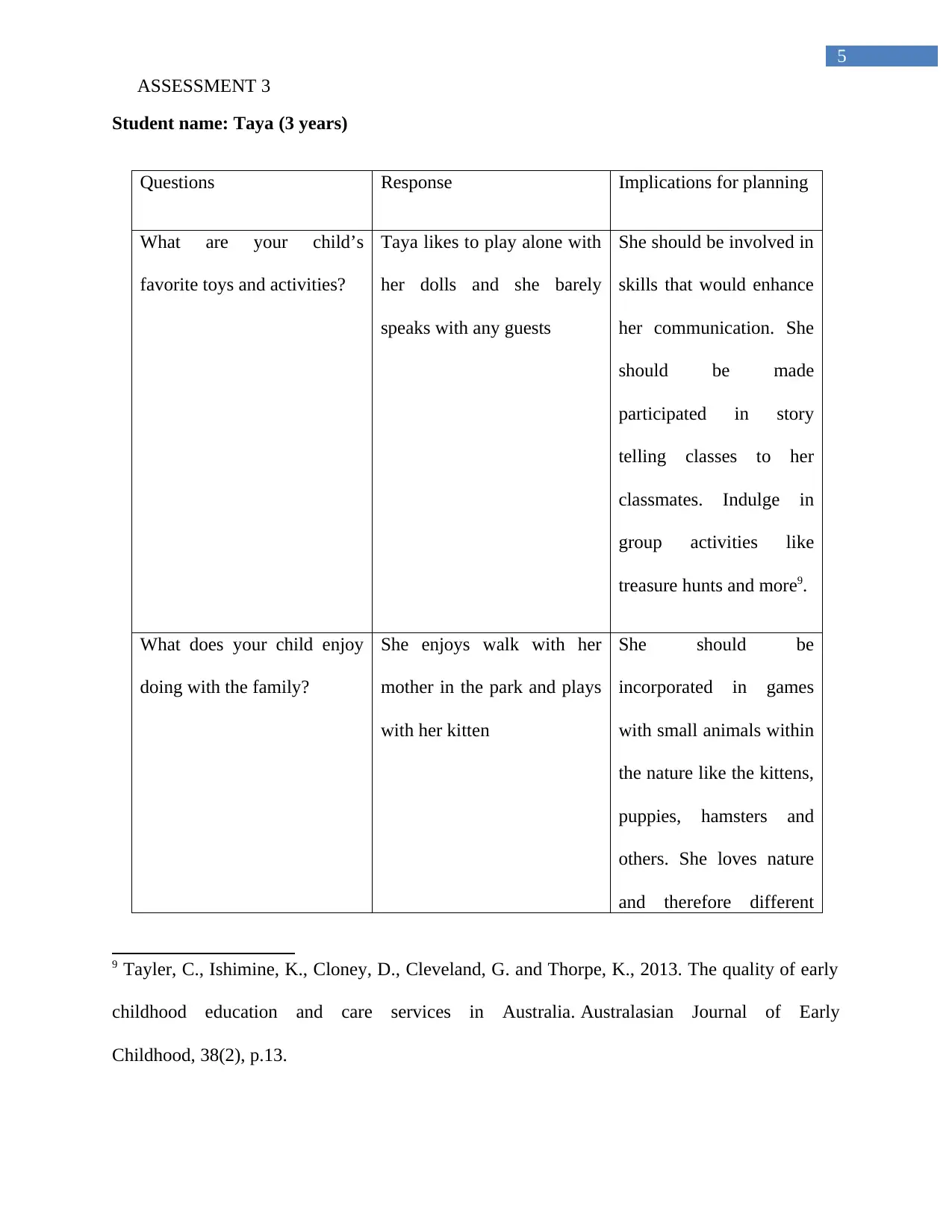
5
ASSESSMENT 3
Student name: Taya (3 years)
Questions Response Implications for planning
What are your child’s
favorite toys and activities?
Taya likes to play alone with
her dolls and she barely
speaks with any guests
She should be involved in
skills that would enhance
her communication. She
should be made
participated in story
telling classes to her
classmates. Indulge in
group activities like
treasure hunts and more9.
What does your child enjoy
doing with the family?
She enjoys walk with her
mother in the park and plays
with her kitten
She should be
incorporated in games
with small animals within
the nature like the kittens,
puppies, hamsters and
others. She loves nature
and therefore different
9 Tayler, C., Ishimine, K., Cloney, D., Cleveland, G. and Thorpe, K., 2013. The quality of early
childhood education and care services in Australia. Australasian Journal of Early
Childhood, 38(2), p.13.
ASSESSMENT 3
Student name: Taya (3 years)
Questions Response Implications for planning
What are your child’s
favorite toys and activities?
Taya likes to play alone with
her dolls and she barely
speaks with any guests
She should be involved in
skills that would enhance
her communication. She
should be made
participated in story
telling classes to her
classmates. Indulge in
group activities like
treasure hunts and more9.
What does your child enjoy
doing with the family?
She enjoys walk with her
mother in the park and plays
with her kitten
She should be
incorporated in games
with small animals within
the nature like the kittens,
puppies, hamsters and
others. She loves nature
and therefore different
9 Tayler, C., Ishimine, K., Cloney, D., Cleveland, G. and Thorpe, K., 2013. The quality of early
childhood education and care services in Australia. Australasian Journal of Early
Childhood, 38(2), p.13.
⊘ This is a preview!⊘
Do you want full access?
Subscribe today to unlock all pages.

Trusted by 1+ million students worldwide
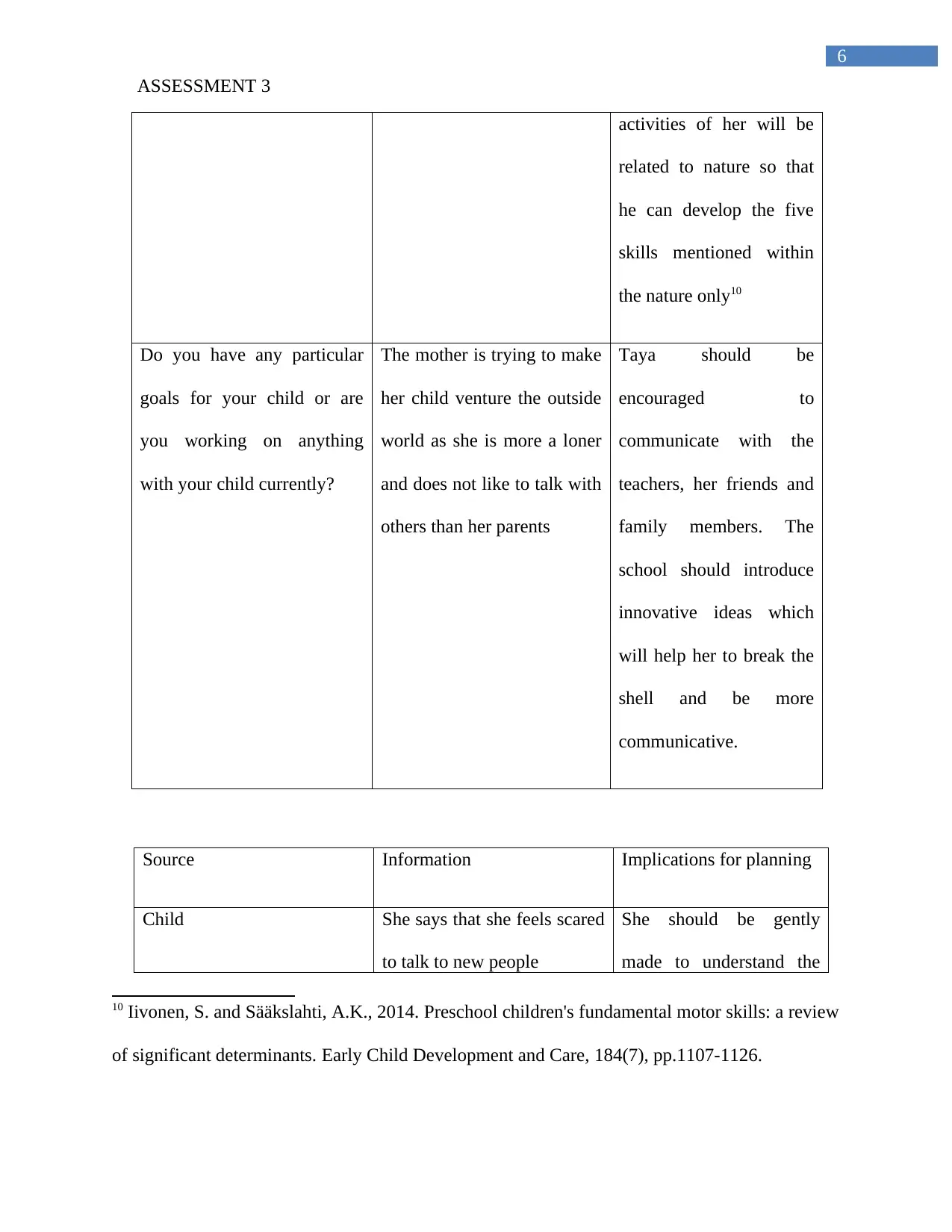
6
ASSESSMENT 3
activities of her will be
related to nature so that
he can develop the five
skills mentioned within
the nature only10
Do you have any particular
goals for your child or are
you working on anything
with your child currently?
The mother is trying to make
her child venture the outside
world as she is more a loner
and does not like to talk with
others than her parents
Taya should be
encouraged to
communicate with the
teachers, her friends and
family members. The
school should introduce
innovative ideas which
will help her to break the
shell and be more
communicative.
Source Information Implications for planning
Child She says that she feels scared
to talk to new people
She should be gently
made to understand the
10 Iivonen, S. and Sääkslahti, A.K., 2014. Preschool children's fundamental motor skills: a review
of significant determinants. Early Child Development and Care, 184(7), pp.1107-1126.
ASSESSMENT 3
activities of her will be
related to nature so that
he can develop the five
skills mentioned within
the nature only10
Do you have any particular
goals for your child or are
you working on anything
with your child currently?
The mother is trying to make
her child venture the outside
world as she is more a loner
and does not like to talk with
others than her parents
Taya should be
encouraged to
communicate with the
teachers, her friends and
family members. The
school should introduce
innovative ideas which
will help her to break the
shell and be more
communicative.
Source Information Implications for planning
Child She says that she feels scared
to talk to new people
She should be gently
made to understand the
10 Iivonen, S. and Sääkslahti, A.K., 2014. Preschool children's fundamental motor skills: a review
of significant determinants. Early Child Development and Care, 184(7), pp.1107-1126.
Paraphrase This Document
Need a fresh take? Get an instant paraphrase of this document with our AI Paraphraser
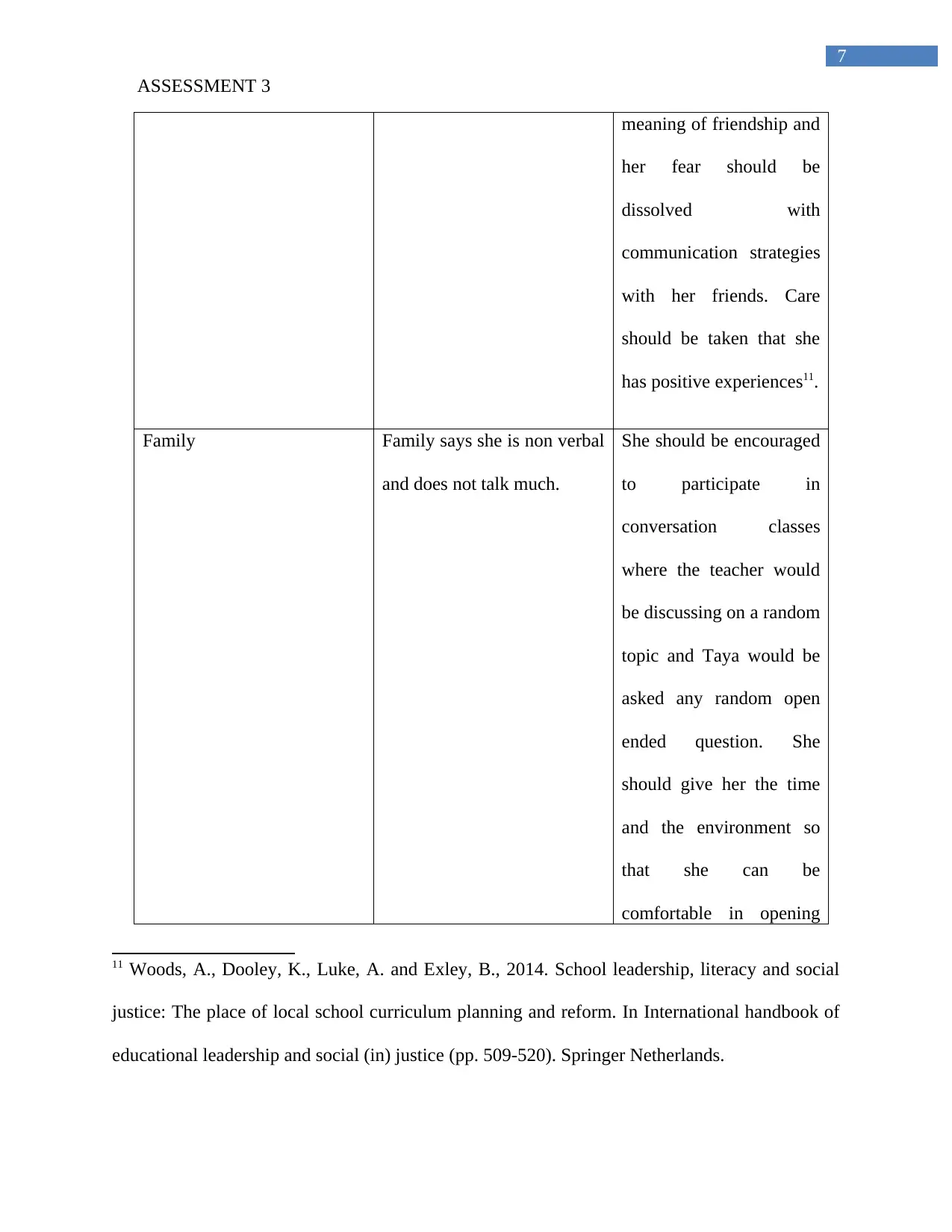
7
ASSESSMENT 3
meaning of friendship and
her fear should be
dissolved with
communication strategies
with her friends. Care
should be taken that she
has positive experiences11.
Family Family says she is non verbal
and does not talk much.
She should be encouraged
to participate in
conversation classes
where the teacher would
be discussing on a random
topic and Taya would be
asked any random open
ended question. She
should give her the time
and the environment so
that she can be
comfortable in opening
11 Woods, A., Dooley, K., Luke, A. and Exley, B., 2014. School leadership, literacy and social
justice: The place of local school curriculum planning and reform. In International handbook of
educational leadership and social (in) justice (pp. 509-520). Springer Netherlands.
ASSESSMENT 3
meaning of friendship and
her fear should be
dissolved with
communication strategies
with her friends. Care
should be taken that she
has positive experiences11.
Family Family says she is non verbal
and does not talk much.
She should be encouraged
to participate in
conversation classes
where the teacher would
be discussing on a random
topic and Taya would be
asked any random open
ended question. She
should give her the time
and the environment so
that she can be
comfortable in opening
11 Woods, A., Dooley, K., Luke, A. and Exley, B., 2014. School leadership, literacy and social
justice: The place of local school curriculum planning and reform. In International handbook of
educational leadership and social (in) justice (pp. 509-520). Springer Netherlands.
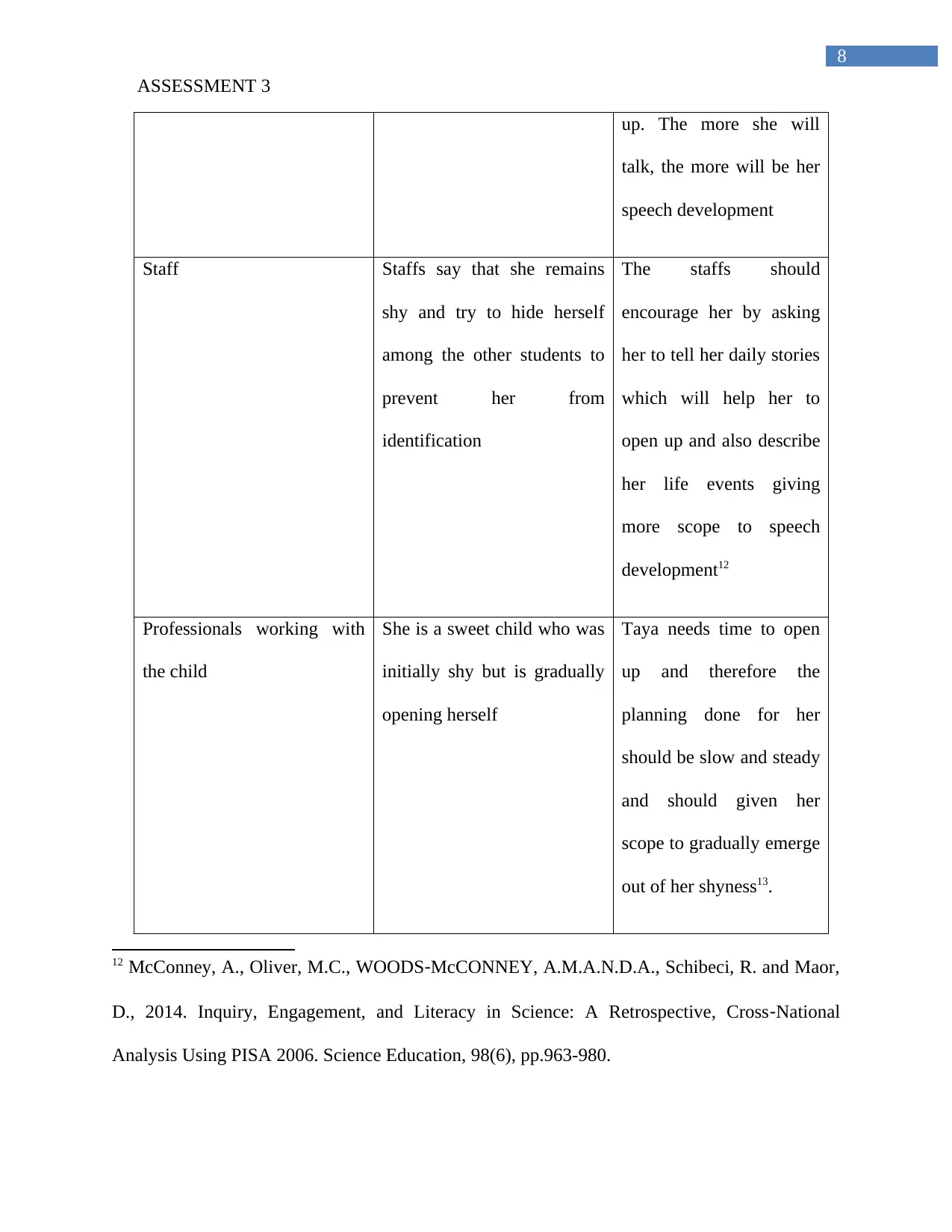
8
ASSESSMENT 3
up. The more she will
talk, the more will be her
speech development
Staff Staffs say that she remains
shy and try to hide herself
among the other students to
prevent her from
identification
The staffs should
encourage her by asking
her to tell her daily stories
which will help her to
open up and also describe
her life events giving
more scope to speech
development12
Professionals working with
the child
She is a sweet child who was
initially shy but is gradually
opening herself
Taya needs time to open
up and therefore the
planning done for her
should be slow and steady
and should given her
scope to gradually emerge
out of her shyness13.
12 McConney, A., Oliver, M.C., WOODS‐McCONNEY, A.M.A.N.D.A., Schibeci, R. and Maor,
D., 2014. Inquiry, Engagement, and Literacy in Science: A Retrospective, Cross‐National
Analysis Using PISA 2006. Science Education, 98(6), pp.963-980.
ASSESSMENT 3
up. The more she will
talk, the more will be her
speech development
Staff Staffs say that she remains
shy and try to hide herself
among the other students to
prevent her from
identification
The staffs should
encourage her by asking
her to tell her daily stories
which will help her to
open up and also describe
her life events giving
more scope to speech
development12
Professionals working with
the child
She is a sweet child who was
initially shy but is gradually
opening herself
Taya needs time to open
up and therefore the
planning done for her
should be slow and steady
and should given her
scope to gradually emerge
out of her shyness13.
12 McConney, A., Oliver, M.C., WOODS‐McCONNEY, A.M.A.N.D.A., Schibeci, R. and Maor,
D., 2014. Inquiry, Engagement, and Literacy in Science: A Retrospective, Cross‐National
Analysis Using PISA 2006. Science Education, 98(6), pp.963-980.
⊘ This is a preview!⊘
Do you want full access?
Subscribe today to unlock all pages.

Trusted by 1+ million students worldwide
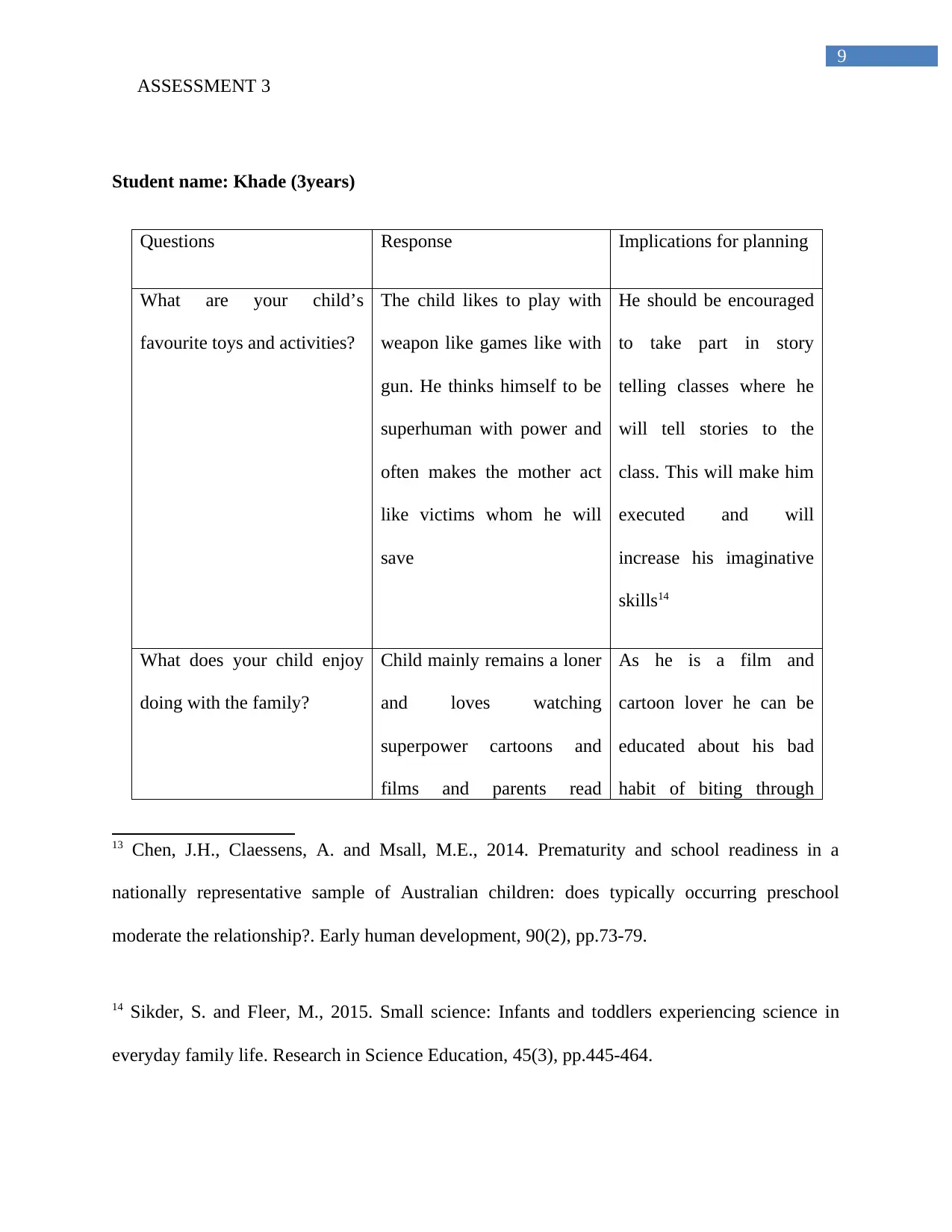
9
ASSESSMENT 3
Student name: Khade (3years)
Questions Response Implications for planning
What are your child’s
favourite toys and activities?
The child likes to play with
weapon like games like with
gun. He thinks himself to be
superhuman with power and
often makes the mother act
like victims whom he will
save
He should be encouraged
to take part in story
telling classes where he
will tell stories to the
class. This will make him
executed and will
increase his imaginative
skills14
What does your child enjoy
doing with the family?
Child mainly remains a loner
and loves watching
superpower cartoons and
films and parents read
As he is a film and
cartoon lover he can be
educated about his bad
habit of biting through
13 Chen, J.H., Claessens, A. and Msall, M.E., 2014. Prematurity and school readiness in a
nationally representative sample of Australian children: does typically occurring preschool
moderate the relationship?. Early human development, 90(2), pp.73-79.
14 Sikder, S. and Fleer, M., 2015. Small science: Infants and toddlers experiencing science in
everyday family life. Research in Science Education, 45(3), pp.445-464.
ASSESSMENT 3
Student name: Khade (3years)
Questions Response Implications for planning
What are your child’s
favourite toys and activities?
The child likes to play with
weapon like games like with
gun. He thinks himself to be
superhuman with power and
often makes the mother act
like victims whom he will
save
He should be encouraged
to take part in story
telling classes where he
will tell stories to the
class. This will make him
executed and will
increase his imaginative
skills14
What does your child enjoy
doing with the family?
Child mainly remains a loner
and loves watching
superpower cartoons and
films and parents read
As he is a film and
cartoon lover he can be
educated about his bad
habit of biting through
13 Chen, J.H., Claessens, A. and Msall, M.E., 2014. Prematurity and school readiness in a
nationally representative sample of Australian children: does typically occurring preschool
moderate the relationship?. Early human development, 90(2), pp.73-79.
14 Sikder, S. and Fleer, M., 2015. Small science: Infants and toddlers experiencing science in
everyday family life. Research in Science Education, 45(3), pp.445-464.
Paraphrase This Document
Need a fresh take? Get an instant paraphrase of this document with our AI Paraphraser
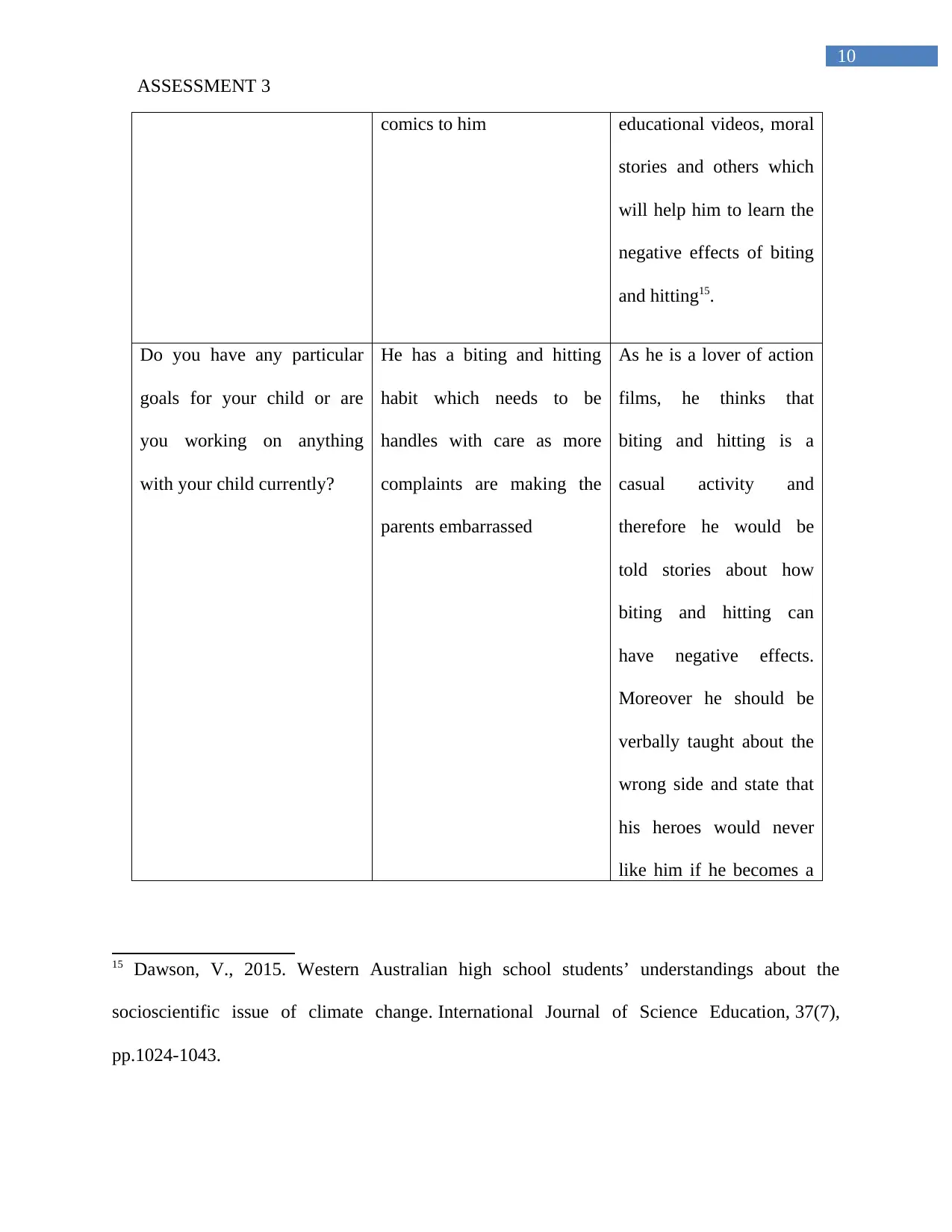
10
ASSESSMENT 3
comics to him educational videos, moral
stories and others which
will help him to learn the
negative effects of biting
and hitting15.
Do you have any particular
goals for your child or are
you working on anything
with your child currently?
He has a biting and hitting
habit which needs to be
handles with care as more
complaints are making the
parents embarrassed
As he is a lover of action
films, he thinks that
biting and hitting is a
casual activity and
therefore he would be
told stories about how
biting and hitting can
have negative effects.
Moreover he should be
verbally taught about the
wrong side and state that
his heroes would never
like him if he becomes a
15 Dawson, V., 2015. Western Australian high school students’ understandings about the
socioscientific issue of climate change. International Journal of Science Education, 37(7),
pp.1024-1043.
ASSESSMENT 3
comics to him educational videos, moral
stories and others which
will help him to learn the
negative effects of biting
and hitting15.
Do you have any particular
goals for your child or are
you working on anything
with your child currently?
He has a biting and hitting
habit which needs to be
handles with care as more
complaints are making the
parents embarrassed
As he is a lover of action
films, he thinks that
biting and hitting is a
casual activity and
therefore he would be
told stories about how
biting and hitting can
have negative effects.
Moreover he should be
verbally taught about the
wrong side and state that
his heroes would never
like him if he becomes a
15 Dawson, V., 2015. Western Australian high school students’ understandings about the
socioscientific issue of climate change. International Journal of Science Education, 37(7),
pp.1024-1043.
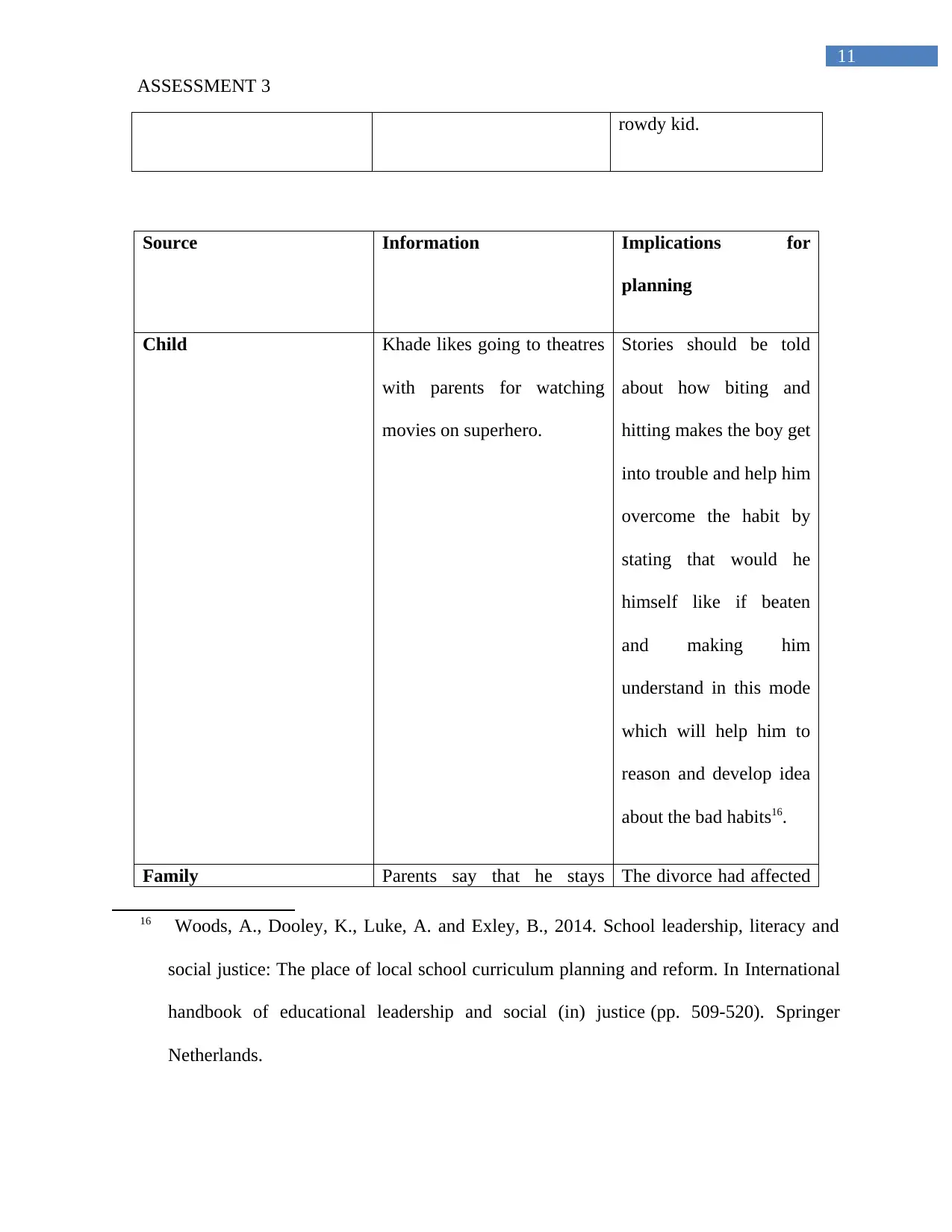
11
ASSESSMENT 3
rowdy kid.
Source Information Implications for
planning
Child Khade likes going to theatres
with parents for watching
movies on superhero.
Stories should be told
about how biting and
hitting makes the boy get
into trouble and help him
overcome the habit by
stating that would he
himself like if beaten
and making him
understand in this mode
which will help him to
reason and develop idea
about the bad habits16.
Family Parents say that he stays The divorce had affected
16 Woods, A., Dooley, K., Luke, A. and Exley, B., 2014. School leadership, literacy and
social justice: The place of local school curriculum planning and reform. In International
handbook of educational leadership and social (in) justice (pp. 509-520). Springer
Netherlands.
ASSESSMENT 3
rowdy kid.
Source Information Implications for
planning
Child Khade likes going to theatres
with parents for watching
movies on superhero.
Stories should be told
about how biting and
hitting makes the boy get
into trouble and help him
overcome the habit by
stating that would he
himself like if beaten
and making him
understand in this mode
which will help him to
reason and develop idea
about the bad habits16.
Family Parents say that he stays The divorce had affected
16 Woods, A., Dooley, K., Luke, A. and Exley, B., 2014. School leadership, literacy and
social justice: The place of local school curriculum planning and reform. In International
handbook of educational leadership and social (in) justice (pp. 509-520). Springer
Netherlands.
⊘ This is a preview!⊘
Do you want full access?
Subscribe today to unlock all pages.

Trusted by 1+ million students worldwide
1 out of 55
Related Documents
Your All-in-One AI-Powered Toolkit for Academic Success.
+13062052269
info@desklib.com
Available 24*7 on WhatsApp / Email
![[object Object]](/_next/static/media/star-bottom.7253800d.svg)
Unlock your academic potential
Copyright © 2020–2025 A2Z Services. All Rights Reserved. Developed and managed by ZUCOL.





